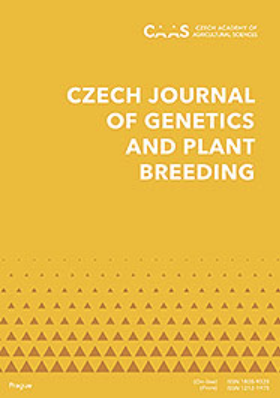Identification of known leaf rust resistance genes in bread wheat cultivars from China
IF 1.8
4区 农林科学
Q3 AGRONOMY
引用次数: 2
Abstract
Leaf rust caused by Puccinia triticina Eriks. (Pt) is one of the most devastating fungal pathogens affecting wheat (Triticum aestivum L.) production worldwide. Deployment of resistant cultivars is the most environmentally friendly approach to control the disease. In this study, thirty-seven wheat lines from the Hubei and Shaanxi provinces in China were evaluated for seedling resistance in the greenhouse using eighteen Pt races. These lines were also tested for slow rusting resistance in the field in the 2014 to 2018 growing seasons. Eleven molecular markers closely associated with known Lr genes were used as part of the postulation process. Seven known Lr genes, 1, 13, 18, 14a, 26, 34 and 46 either singly or in combination were postulated in twenty-five cultivars. Lr1 and Lr26 were the most commonly identified genes detected in thirteen and ten cultivars, respectively. Lr13 and Lr46 were each found in four and five cultivars. Lr34 was present in three cultivars. Lr18 and Lr14a were identified in cultivar Xi’nong 538. Six cultivars displayed slow rusting resistance in the field tests. The resistant cultivars identified in the present study can be used as resistance parents in crosses aimed at pyramiding and the deployment of leaf rust resistance genes in China.中国面包小麦品种已知抗叶锈病基因的鉴定
小麦Puccinia triticina Eriks引起的叶锈病。(Pt)是影响全球小麦生产的最具破坏性的真菌病原体之一。部署抗性品种是控制该疾病最环保的方法。在本研究中,用18个Pt小种对来自湖北和陕西的37个小麦品系在温室中的幼苗抗性进行了评估。在2014年至2018年的生长季节,这些生产线也在田间进行了抗慢锈性测试。11个与已知Lr基因密切相关的分子标记被用作推测过程的一部分。在25个品种中推测了7个已知的Lr基因,1、13、18、14a、26、34和46,无论是单独还是组合。Lr1和Lr26是分别在13个和10个品种中检测到的最常见的基因。在4个和5个品种中分别发现了Lr13和Lr46。Lr34存在于三个品种中。在品种西农538中鉴定出Lr18和Lr14a。6个品种在田间试验中表现出缓锈性。本研究鉴定的抗性品种可作为抗性亲本在中国进行叶锈病抗性基因的组合和部署。
本文章由计算机程序翻译,如有差异,请以英文原文为准。
求助全文
约1分钟内获得全文
求助全文
来源期刊

Czech Journal of Genetics and Plant Breeding
Agricultural and Biological Sciences-Plant Science
CiteScore
2.20
自引率
0.00%
发文量
25
审稿时长
>12 weeks
期刊介绍:
Original scientific papers, critical reviews articles and short communications from the field of theoretical and applied plant genetics, plant biotechnology and plant breeding. Papers are published in English.
 求助内容:
求助内容: 应助结果提醒方式:
应助结果提醒方式:


